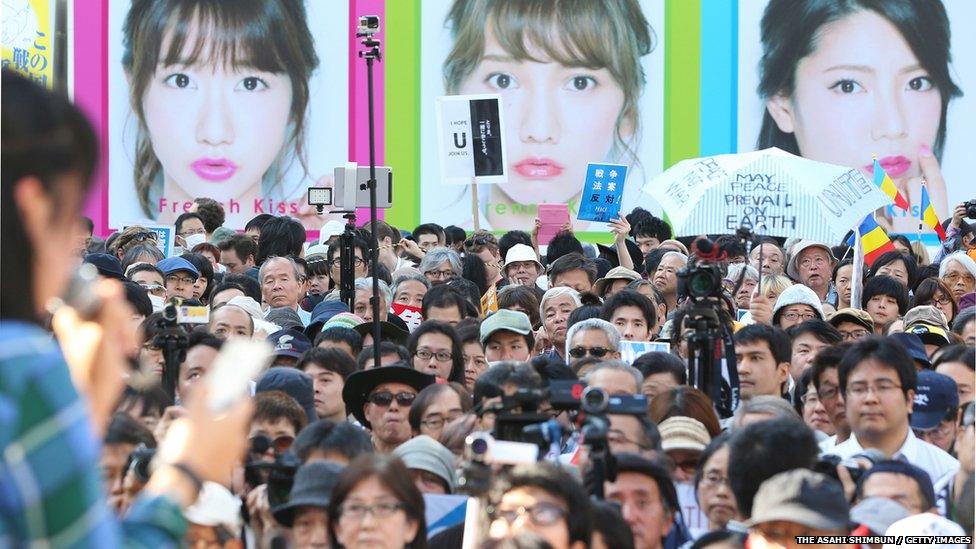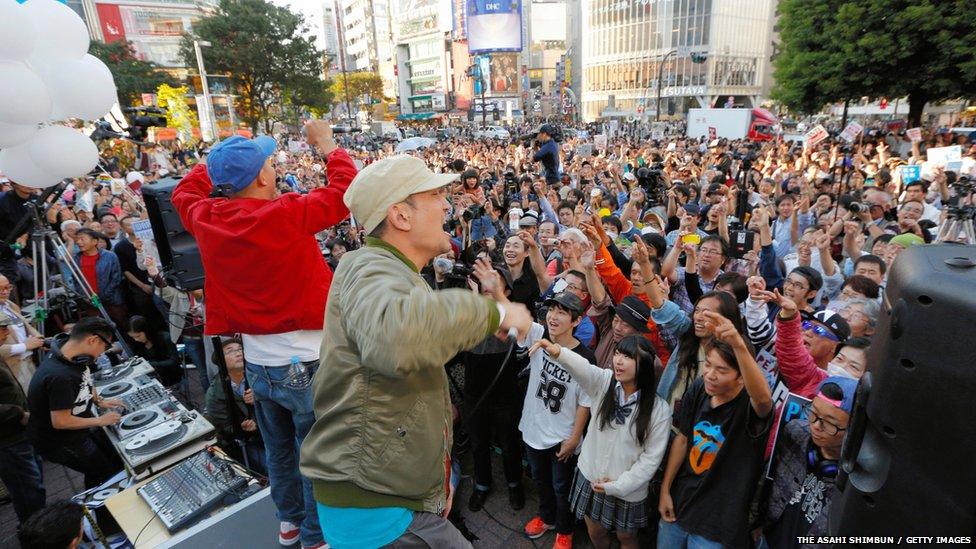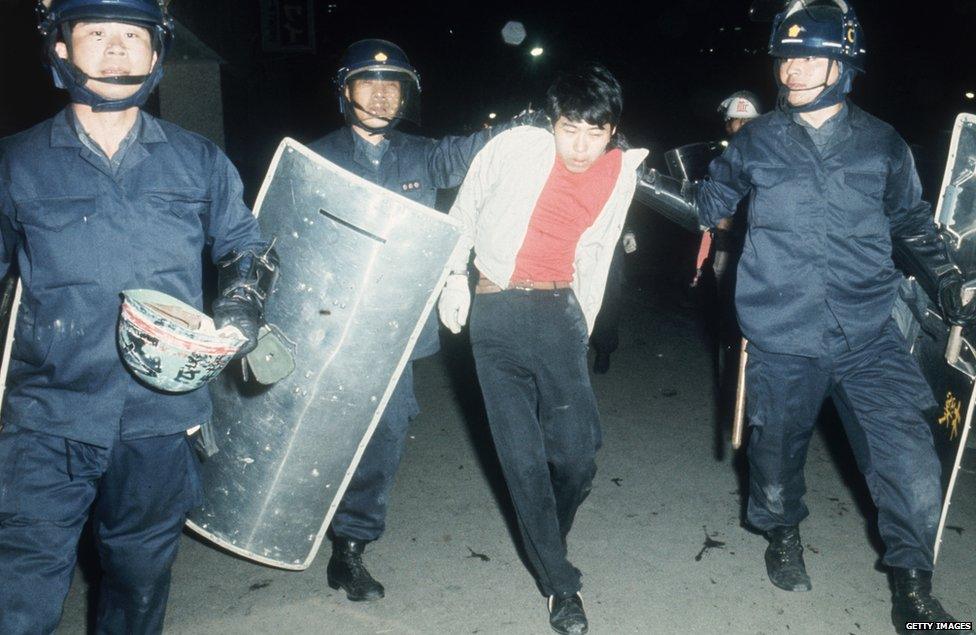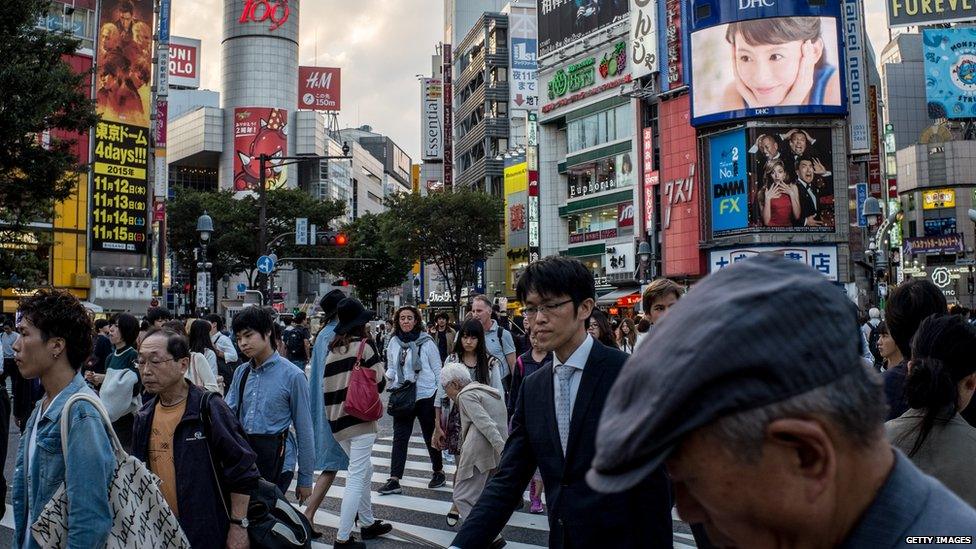Japan's student protests: To the barricades in designer gear
- Published

The protests have defied the idea Japanese youth are politically apathetic
Tokyo's Shibuya crossing is arguably the city's most famous landmark.
With its vast digital screens and incessant buzz of advertising jingles, it is a gateway to Japanese youth culture, with every road leading to brand-name stores and nightclubs.
On Sunday, a month after the government passed a controversial security bill in the face of widespread opposition, the plaza off Shibuya crossing was jammed with student activists, eager to continue their anti-government demonstrations.
Armed with everything from megaphones to turntables and crates of vinyl, they came clad in chic streetwear, making the afternoon half demo, half street party.
There were speeches and call-and-response chants inviting the crowd to "tell me what democracy looks like!"
The proceedings were lent a dash of fashion cred with local indie DJ favourite Chabe spinning reggae and dub records, while hip-hop group Scha Dara Parr made a surprise visit at the end of the proceedings.

Music has been a key feature of the student protests in Japan.
This is Japanese apparel activism in action.
Spearheaded by the Students Emergency Action for Liberal Democracy (Sealds), these protests, which broke out a year ago, have captured the public's imagination with their attention to style, slick visual productions and media savvy.
The group's initial motivation was to oppose Prime Minister Shinzo Abe's decision to reinterpret Japan's pacifist constitution to shift away from a long-term commitment to self-defence, thus raising the possibility that the country could go to war under limited circumstances.
The students also campaigned against punishingly high tuition fees and growing income inequality.
The choice of venue is intentional. As well as regular protests outside Japan's parliament building, the organisers are intent on capturing the hearts and minds of a wider audience.
"By demonstrating here, we have a chance to reach people who might not ordinarily have any interest, and in that sense it feels like there's a real point to it," one of the speakers, philosophy student Kanau Kobayashi, said.

Student protests in the 1960s were violent affairs
It is a far cry from the polarising radicalism and violence that characterised the 1960s student movements in Japan, the last time the government was challenged on any scale over its politics.
The 1960s movement was sparked by opposition to the Vietnam War and oppressive campus policies, and punctuated by violent clashes with the police, mass arrests, and even the death of one University of Tokyo student.
Today's protests share many of the same core liberal beliefs, but unlike those of the 1960s, which were characterised by a strict adherence to Marxist principles and focus on campus protests and solidarity with labour strikes, there is an overwhelming atmosphere of inclusivity and tolerance.
This has proved to be a distinctive departure for the current spate of protests, since political expression is frequently stigmatised in Japanese society.
Tidying up
Some old-style radicals who were on the barricades in the 1960s have dismissed Sealds's fashion-conscious protests as style over substance.
Japan's Zengakuren communist league of students is also particularly dismissive of its light-handed tactics and desire to cooperate with police.
Sealds's weekly demonstrations in front of Japan's parliament building were a model of organisation and good manners. Many student volunteers stayed behind to clean up rubbish until the early hours of the morning.

Tokyo's Shibuya corssing is one of the city's most iconic locations.
But as Sealds's 23-year-old founder, Aki Okuda, has discovered, no involvement is entirely without risk.
So often in the spotlight, Mr Okuda's appearance at Sunday's event was relatively low key by his standards, making a brief cameo on stage at the end while Scha Dara Parr were performing.
This follows a recent death threat against him and his family. Meanwhile, many of Sealds's other more public members are frequently the target of anonymous abuse on their social media channels.
For all their efforts, however, the youth movement was unable to stop the government passing two controversial bills. One allowed the government to designate "sensitive" information as state secrets and criminalise whistleblowers and even journalists reporting such content.
The security reform bills changed Japan's military from a purely defensive force to one that could participate in overseas conflicts.
What is democracy?
But the protests have transformed the current political debate climate, according to politics professor Koichi Nakano.
"They're not just defending constitutionalism or a liberal democracy," he says. "They're starting to push the political spectrum back to the left, something we haven't seen in decades."
Even pro-government media channels, instinctively reticent to write about challenges to the status quo, have had to acknowledge their impact. Other newspapers and television broadcasters lap up their slick, stylish approach to activism.
Sealds's newly published book, What Is Democracy?, which outlines its proposals for its desired form of liberal democracy and is co-authored with former radical activist and novelist Genichiro Takahashi, is a bestseller.
Such is its rapid rise to influence that some wonder if the group might transition from street protests to a more organised, established political entity.

Student leader Aki Okuda has proved adept at mixing serious politics with fashion and style
Some eyebrows were raised when Mr Okuda was invited to address a parliamentary committee about the security laws and pointedly ditched his trademark attire of a Supreme snapback cap and skinny jeans for a suit and tie.
Such a shift would be a major turning point for the group. Members such as Mr Kobayashi are wary that it might mean compromising on the movement's ideals of championing individualism and autonomy among the members.
"I think that whatever Sealds does is going to be hugely important", he says, "but personally I believe that it's also just as important for each and every person to express their own concerns from an individual, ordinary perspective."
Meanwhile, Prof David Slater, who has been heading up research on the group as part of the Voices of Protest Japan ethnographic project, states that such a development, although logical and consistent with Sealds's desire to change things from the inside, is not necessarily without risks.
"There is a danger of being appropriated or subsumed into a political system that is itself largely dysfunctional and some would even say is primarily responsible for the perversion of the democratic process in Japan", he says.
"Sealds has created an independent voice in Japan by being outside of the process. The challenge is to not to lose that voice."
About the author: Mike Sunda is a Tokyo-based writer specialising in music and Japanese youth and urban culture.